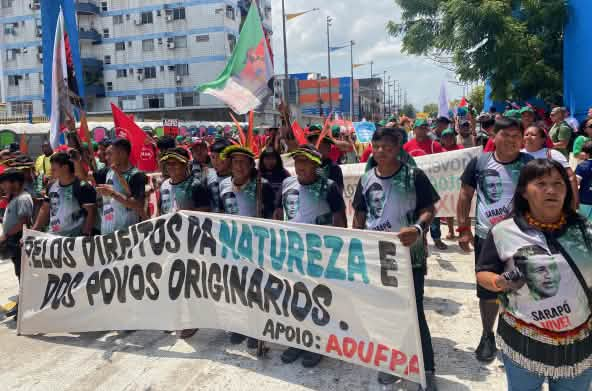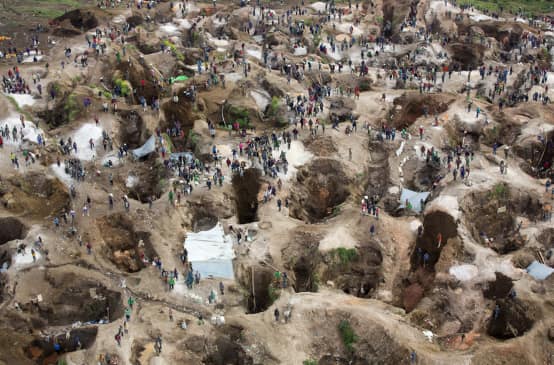
Completed campaign
Philippines: Palm oil and mining threaten Palawan Island, a UNESCO Man & Biosphere Reserve
Indigenous peoples and rural communities are facing the destruction of their livelihoods as natural forest on Palawan island, Philippines is being destroyed for palm oil and mining while other traditional food zones and non timber forest products reserves are being replaced by oil palm plantations. Palawan is part of the UNESCO Man and Biosphere Reserve programme, with 49 animal and 56 plant species listed by IUCN as globally threatened. Please sign a petition against the destruction of indigenous peoples' farmlands and rainforests by nickel mining and palm oil expansion.
Indigenous peoples and rural communities are facing the destruction of their livelihoods as natural forest on Palawan island, Philippines is being destroyed for palm oil and mining while other traditional food zones and non timber forest products reserves are being replaced by oil palm plantations. Palawan is part of the UNESCO Man and Biosphere Reserve programme, with 49 animal and 56 plant species listed by IUCN as globally threatened.
Since the National Policy Agenda on Revitalizing Mining in the Philippines (Executive Order No. 270-A) was issued on January 16, 2004, under thee previous government of Gloria Arroyo, mining companies have been allowed to exploit the Country's last remaining biodiversity hot-spots, including in so called "restricted" and "core" zones of maximum protection where, extractive activities and other forms of human exploitation are prohibited by law. Civil society calls to the new elected president "Noynoy" Aquino, to stop mining companies' operations in the last Philippines's tropical forest, have so far been ignored.
Indigenous fallow lands, essential for traditional swidden agriculture, and other areas used for the gathering of minor non-timber forest products are also being converted into oil palm plantations. This is going to have a significant impact on both indigenous peoples and rural communities, who heavily depend on natural resources for the collection of plant material for house building, basketry, medicines, food and other purposes. In some municipalities of Palawan, oil palms are already competing with and taking over cultivated areas, which are sustaining local self-sufficiency.
Mining companies are building roads inside the highly biodiverse forests and watersheds, causing deforestation, soil erosion and landslides and undermining the livelihoods of indigenous communities and lowland farmers.
The local indigenous network ALDAW (Ancestral Land/Domain Watch), together with other local organisations and NGOs in Palawan, is calling on the government to stop palm oil expansion as well as the construction of mining roads, to cancel mining concessions which threaten watersheds, forests and communities, and above all to revoke the infamous "executive order 270-A". Please, sign the petition below to support their demands.
For more information on oil palm expansion in Palawan, please see http://intercontinentalcry.org/wp-content/uploads/Agrofuels-in-Palawan.pdf, www.plant-talk.org/philippines-expanding-oil-palm-palawan.htm and the video at http://vimeo.com/16570512 For more information on the Palawan communities impacted by mining, please see the video at www.youtube.com/user/ALDAWpalawan#p/u/9/l_cKJOF1dOA and for detailed reports about the threatened Bulanjao and Gantong biodiversity hot spots see www.survivalinternational.org/tribes/palawan
To: The President of the Republic of the Philippines
We, the undersigned are extremely concerned about the situation of the indigenous peoples and rural communities of Palawan Island (the Philippines' last ecological frontier). Palawan is part of the Man and Biosphere Reserve program of UNESCO and hosts 49 animals and 56 botanical species found in the IUCN Red List of Threatened Species.
MacroAsia mining corporation and Celestial Nickel Mining Exploration Corporation (currently being operated by Ipilan Nickel Corporation) have been given rights over the land of indigenous Palawan communities, some of whom have very little contact with the outside world. These mining concessions are even within the Core and Restricted Zones, which should be protected by the Strategic Environmental Plan for Palawan. Mining in these areas will devastate the communities and the land they rely on to survive.
We are also concerned at the Provincial government's plans for thousands of hectares of biofuel plantations, especially oil palm. These will reduce local biodiversity and the indigenous people's ability to access their natural resources.
The Rio Tuba Nickel Mining Corporation (RTNMC) is building roads in the Bulanjao range (a biodiversity hotspot), which are causing environmental damage such as landslides, soil erosion and deforestation of watersheds. This is threatening the health and livelihood of both Palawan indigenous communities and lowland farmers.
Moreover, we are concerned about reports that the National Commission on Indigenous Peoples (NCIP), in Palawan, is not supporting the interests of its indigenous constituents. As a result, consultative processes carried out by NCIP do not allow the indigenous people to exert their free, prior and informed consent, to which they are entitled by national and international law.
Although the 25-year moratorium on small-scale mining is welcome, it will not stop large-scale mining in the province. Furthermore, the newly approved Mantalingahan Protected Area does not provide protection for the Gantong watersheds. In fact, these areas, inhabited by vulnerable and isolated Palawan communities, are included in the mining claims of MacroAsia Corporation, which will remain valid.
We urge the national government to revoke the 1995 Mining Act, which has been so disastrous for indigenous peoples and rural communities in the Philippines and to cancel both MacroAsia's and Celestial's mining claims in the uplands of Brooke's Point Municipality and in Gantong watersheds. These have been granted without the genuine free prior and informed consent of the indigenous inhabitants.
Finally, we urge you to ensure that the construction of mining roads in the watersheds of Bulanjao range, and plans to increase oil palm plantations, are stopped immediately in accordance with the Indigenous Peoples' Rights Act and the Strategic Environmental Plan for Palawan.
Sincerely,
Ausgangslage – Schmutziges Gold
Goldvorkommen gibt es fast überall auf der Erde.
Das kostbare Metall wird mit 55 Prozent hauptsächlich zu Schmuck verarbeitet, 25 Prozent dienen zu Spekulationszwecken als private finanzielle Wertanlage und 11 Prozent werden von staatlichen Zentralbanken in Tresoren gelagert. Die US-Regierung besitzt mit 8.134 Tonnen mit Abstand den größten Goldbestand. Die Deutsche Bundesbank kommt mit 3.369 Tonnen an zweiter Stelle. Nur etwa 8 Prozent des Goldes gehen in die der Elektronikindustrie für Handys, Laptops und andere elektronische Geräte.
Gold kann als körnerartige Goldseifen (Nuggets), die mechanisch vom Bodensubstrat getrennt werden, vorkommen. Weitaus häufiger findet sich das Edelmetall jedoch in feinsten Spuren in der Gitterstruktur der Gesteinsminerale oder als Goldstaub in den Sedimenten von Flüssen. Um das Gold herauszulösen und zu binden, werden die Gesteine zermahlen und dann mit Chemikalien versetzt.
Im großindustriellen Goldabbau wird das äußerst umweltschädliche Zyanid-Lauge-Verfahren angewandt. Um eine Tonne Gold zu fördern, müssen durchschnittlich 150 Tonnen Zyanid eingesetzt werden. Bereits wenige Milliliter davon sind tödlich für den Menschen.
Das Quecksilber-Verfahren kommt häufig bei Kleinschürfern zur Anwendung. Die goldhaltigen Erze werden zunächst stundenlang im Wasser gesiebt, bis der Goldstaub im Bodensatz konzentriert ist. Dieser goldhaltige Gesteinsschlamm wird dann mit Quecksilber gemischt, das mit dem Gold eine flüssige Legierung (Amalgam) eingeht. Diese Legierung wird erhitzt, das toxische Schwermetall verdampft und übrig bleibt reines Gold. Schutzanzüge gegen das Nervengift oder Rückgewinnungsvorrichtungen für das verdampfende Quecksilber sucht man beim Goldabbau durch Kleinschürfer oft vergeblich. Lukrative Geschäfte mit dem Edelmetall machen vor allem Kapitalgeber, Transportunternehmen und Chemikalienhändler. Menschen und Natur leiden unter dem Goldabbau.
Auswirkungen –Toxische Wüsten statt artenreicher Regenwälder
Durch Zyanid und Quecksilber werden Böden und das Grundwasser auf ewig verseucht. Selbst wenn Goldminen stillgelegt werden, gibt zyanidbehandeltes Gestein viele Jahrzehnte später giftige Schwefelsäuren ab.
Der industrielle Goldabbau benötigt zudem Unmengen an Wasser. Das kontaminierte Wasser wird zusammen mit den Gesteinsschlämmen in riesige Auffangbecken unter freiem Himmel gepumpt. Permanent versickern dabei große Mengen giftiger Abwässer in die Böden und werden in Bäche geleitet. Durch mangelhafte Konstruktion der Dämme oder nach starken Regenfällen kommt es immer wieder zu Dammbrüchen, bei denen sich innerhalb von Minuten Millionen Tonnen der toxischen Schlämme in die Umwelt und Flüsse ergiessen. Im Jahr 2000 in Rumänien verseuchten schwermetallhaltige Schlämme die Theiss, den größten Zufluss der Donau. Jegliches Leben in den Gewässern wurde ausgerottet. Die Giftbelastung war bis in die mehrere hundert Kilometer entfernte Donau nachzuvollziehen.
Im Regenwald kommt die Abholzung der Urwaldriesen für den Goldabbau hinzu. Bagger wühlen die Erde um, mit Wasserpumpen werden die Böden weggespült und durchsiebt, um goldstaubhaltigen Schlamm anzureichern und dann das Edelmetal mit Quecksilber zu binden. So entstehen entlang der Flüsse verseuchte Mondlandschaften. Um nur 0,24 Gramm Gold zu erhalten, entstehen 1000 Kilo Sondermüll und Abraum. Ein einzelner Goldring produziert demnach 20 Tonnen lebensgefährlichen Giftmüll.
Die Menschenrechtsorganisation Human Rights Watch warnt, dass Kinderarbeit in der Goldgewinnung weit verbreitet ist. Kinder können in enge Schächte klettern und waschen mit bloßen Händen die goldhaltigen Erze in Quecksilberlaugen.
Die Lösung – Vier Goldene Regeln zum Schutz von Mensch und Natur
Wurde auch mein Goldschmuck unter diesen menschenunwürdigen und umweltverpestenden Bedingungen hergestellt? Den verschlungenen Goldpfad nachzuverfolgen, ist aufgrund der Vielzahl der Akteure äußerst schwierig. Die Goldraffinerien, die mehrheitlich in der Schweiz sitzen und zusammen 70 Prozent der Weltproduktion ausmachen, geben an, den Rohstoff von zertifizierten Händlern zu beziehen. Auf den zweiten Blick zeigt sich allerdings, dass viele Verkäufer Scheingeschäfte mit falschen Adressen führen (Filmtipp: „Dreckiges Gold - Die glänzenden Geschäfte mit dem edlen Metall“).
Auch wir tragen für die Auswirkungen Verantwortung: Was kann jeder einzelne also tun?
1. Konsum überdenken: Braucht man jedes Jahr ein neues Smartphone? Nutzen Sie Elektronikgeräte wie Handys und Laptops möglichst lange. Wenn die Funktionen versagen, können Sie das Gerät aussortieren – aber dann bitte in einer Recyclingstelle abgeben. Wussten Sie, dass laut einer UNO-Berechnung in nur 49 Handys soviel Gold enthalten ist wie in einer Tonne Golderz?
2. Schmuck umarbeiten: Goldschmuck, der aus der Mode gekommen ist oder einfach nicht mehr gefällt, lässt sich problemlos umarbeiten. Der Regenwald wird es danken.
4. Gold taugt nicht als Investition: Ist Gold wirklich ein sicherer Anker in Finanzkrisen? Experten raten davon ab. Und außerdem: Eine ethische und verantwortungsvolle Finanzanlage ist Gold nicht.
5. Wissen in die Welt transportieren: Machen Sie auf die umweltschädlichen Giftstoffe beim Tagebau, den Raubbau an der Natur und die unmenschlichen Arbeitsbedingungen aufmerksam, indem Sie unseren kostenlosen Regenwald Report mit fundierten Artikeln zu Regenwaldthemen beim Friseur oder Arzt auslegen. Gerne senden wir Ihnen hierfür ausreichend Exemplare zu.

